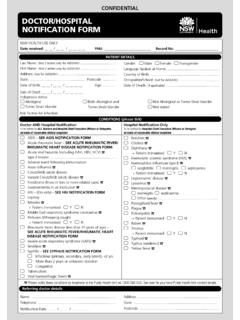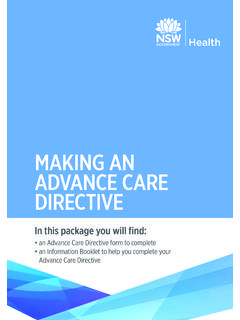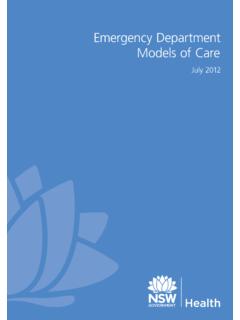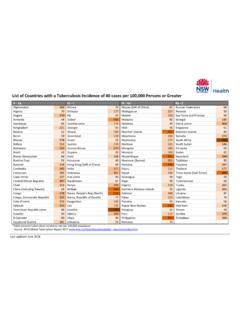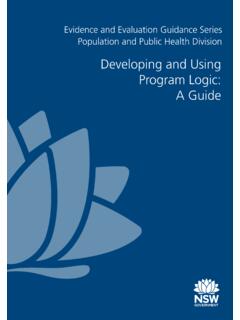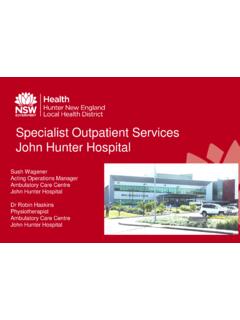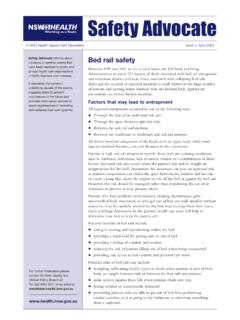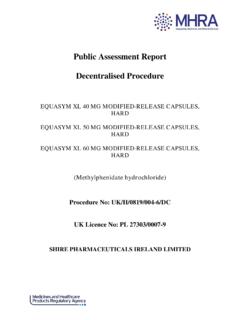Transcription of CRITERIA FOR THE DIAGNOSIS AND MANAGEMENT OF …
1 CRITERIA FOR THE DIAGNOSIS AND MANAGEMENT OF attention deficit hyperactivity DISORDER IN CHILDREN AND ADOLESCENTS This document replaces TG181/9. This document draws on various reputable guidelines and research papers that have been published on ADHD and its MANAGEMENT (see References at the end of Part A). The document consists of two parts: PART A deals with Clinical Issues Relating to the DIAGNOSIS and MANAGEMENT of attention deficit hyperactivity Disorder in Children and Adolescents . PART B deals with Legal, Policy and Procedural Issues Relating to the Prescribing of Dexamfetamine, Methylphenidate and Lisdexamfetamine for attention deficit hyperactivity Disorder in Children and Adolescents . It is important that the MANAGEMENT of patients is in accordance with Part A.
2 This document can be obtained at or by contacting the Pharmaceutical Regulatory Unit on (02) 9391 9944. For general information on ADHD, visit the Ministry of Health s website on ADHD at TG181/10 Issue date: April 2016 Page 1 PART A Clinical Issues Relating to the DIAGNOSIS and MANAGEMENT of attention deficit hyperactivity Disorder (ADHD) in Children and Adolescents 1. CRITERIA FOR DIAGNOSIS As a minimum, the CRITERIA set down in DSM-IV should be fulfilled before a DIAGNOSIS of ADHD is made. 2. AETIOLOGY The aetiology of ADHD is essentially unknown. Evidence suggests that many factors, including genetic, neurophysiologic, cognitive, familial and environmental factors are involved. It is likely that a combination of these factors contributes to the symptoms of ADHD.
3 3. PREVALENCE Reported estimates of the community prevalence of ADHD vary widely depending on the method of ascertainment, the diagnostic CRITERIA used, and the population sampled. Australian studies have generally found prevalence rates of ADHD between and Most studies have found a higher prevalence of ADHD in boys than girls, with boys scoring higher particularly on measures of hyperactivity and disruptive behaviour scales. 4. ASSESSMENT A comprehensive assessment of a child with suspected ADHD should include the following elements: History: Family, past and current medical, psychosocial and developmental. Medical: Physical and neurological examination and any appropriate investigations.
4 Developmental: To exclude significant specific and/or global problems, hearing and vision difficulties, and provide further referral as appropriate. Behavioural: Description of behaviour in various settings, especially home and school. Family and Relationship Function: An assessment of the child s relationship with family members, the overall functioning of the family and the child's relationships with peers. Educational: A review of classroom observations and prior testing, including estimates of intellectual capabilities (incorporating intellectual/cognitive assessment), strengths and weaknesses and measure of academic achievement, including language development. Multiple sources of information should be utilised during assessment, such as parents, caregivers and relevant professionals, especially teachers.
5 Appropriate rating scales should be used as part of the assessment for obtaining systematic information from different settings and to gauge treatment response. TG181/10 Issue date: April 2016 Page 2 5. TREATMENT APPROACH It is important to treat ADHD because of its disruptive symptoms, associated learning, behavioural and emotional problems, family stress, and possible persistence into adolescence and adulthood. ADHD is a chronic condition that requires ongoing MANAGEMENT and monitoring. The choice of treatment strategies is influenced by the child s specific target symptoms, comorbidity, and the strengths and weaknesses of the child as well as the child s parents and caregivers. Multimodal therapy is widely advocated for the MANAGEMENT of ADHD.
6 Strategies may include medication, behaviour therapy, family support, and developmental therapies such as language therapy. A MANAGEMENT plan for a child with ADHD should be individualised to the needs of the child and his/her family, as determined by a comprehensive assessment. It should take account of associated problems such as peer relationships, low self-esteem, family dysfunction, and comorbid conditions such as learning difficulties, anxiety and depression. It should also be developed in accordance with the family s resources and capacity to adhere to the plan. Educating parents and the child about the disorder and how it may affect learning, behaviour, self-esteem, social skills and functioning within the family, as well as providing information on the advantages and disadvantages of potential treatment strategies, will enable the most effective MANAGEMENT plan to be developed for the child.
7 Many agencies and professionals may be involved in multimodal MANAGEMENT . It is particularly important to establish a therapeutic alliance with the child s parents and other significant caregivers ( day care providers, school teachers) to enable specific treatment interventions to be implemented consistently. Over time a number of factors can affect a child s target symptoms, such as normal developmental changes, greater academic demands and educational expectations with increasing grade, and changes in the home environment and availability of resources. Regular review is important to ensure that the MANAGEMENT strategies remain appropriate and effective. Frequency of review will depend on age, stage and complexity of treatment, educational and family factors, and should involve three to six monthly review.
8 At a minimum, a review should occur once a year covering medication, educational progress and behaviour in home and other settings. Such a review should include information from multiple sources ( parents, other significant caregivers, teachers) and include an evaluation of any reported deterioration in target symptoms or other behaviours. TG181/10 Issue date: April 2016 Page 3 6. THE ROLE OF PSYCHOSTIMULANT MEDICATION IN THE MANAGEMENT OF ADHD The need for medication and its effectiveness is relative to the nature and severity of problems and the use of other interventions. Although medication is the most effective short-term treatment for the core symptoms of ADHD, other approaches may add to the success of medication and may be essential if medication is ineffective.
9 Despite widespread clinical and scientific support for the use of psychostimulants in the MANAGEMENT of ADHD, the popular media continues to portray psychostimulant treatment as controversial. Consequently, parents of children presenting with ADHD may be fearful or suspicious about psychostimulant treatment. Prescribers should be mindful of this and inquire into any concerns a parent or a child may have about psychostimulant medication. Appropriate written information is useful. The benefits of psychostimulant therapy and the possible side effects should be comprehensively discussed before a child is commenced on psychostimulant medication. 7. PSYCHOSTIMULANT MEDICATION Note: Prescribers should be familiar with the current product information regarding the use of methylphenidate, dexamfetamine and lisdexamfetamine before prescribing these medications.
10 Dexamfetamine, lisdexamfetamine and methylphenidate act on dopaminergic and noradrenergic neurotransmitter pathways and appear to influence mainly prefrontal, frontal and limbic systems with benefits on disruptive behavioural inhibition, impulse control, selective attention , active working memory and executive functioning. There is no paradoxical effect of psychostimulants appearing to sedate disruptive behaviour. There are no direct effects on consciousness or moral judgment. Though similar in clinical effects, the psychostimulants differ in how they increase neurotransmitter concentrations in the synapse. There is wide individual variation in metabolism and effect. The duration of action varies according to the format of the medication and the individual patient s rate of metabolic breakdown.
